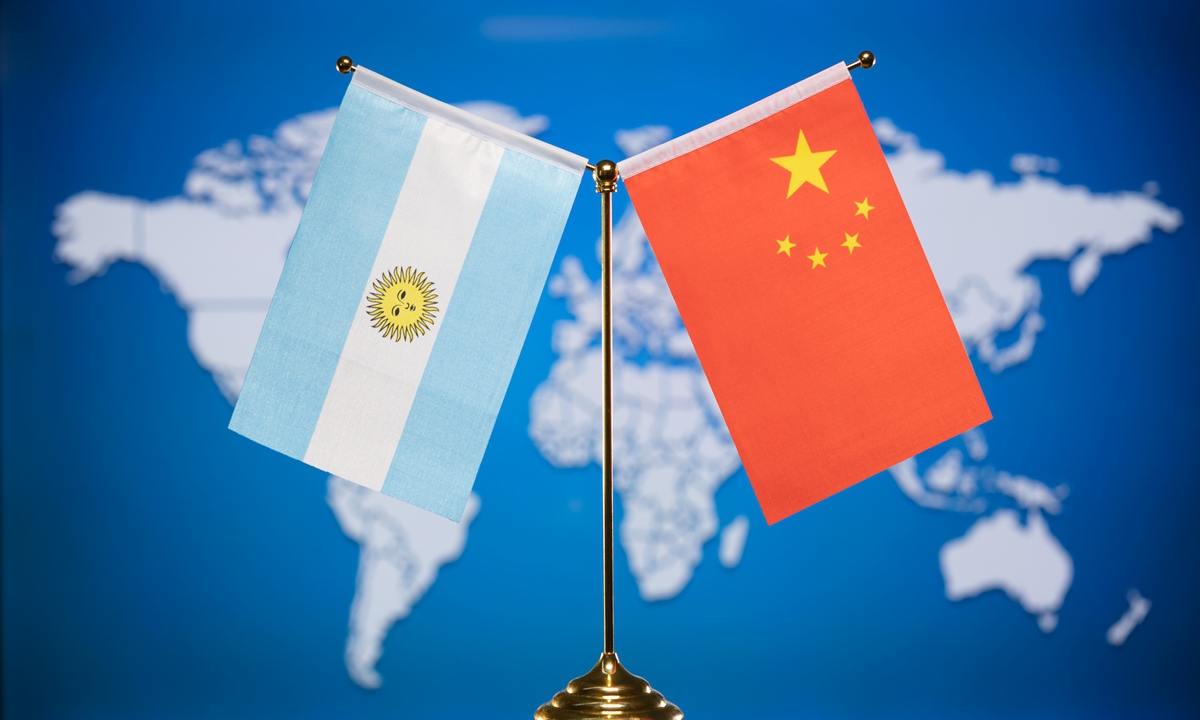China, Argentina expand currency swap scale as closer economic ties boost yuan’s use in Latin America

National flags of China and Argentina Photo: VCG
China and Argentina have expanded a currency swap deal, which experts said will help the Latin American country hedge against shocks brought about by the US' financial policy tightening while promoting its own industrial development.
It is likely that more Latin American countries will increase the use of Chinese yuan in order to counter the US dollar's hegemony, and strengthen economic ties with China.
The heads of the Argentine and Chinese central banks confirmed that the deal for the swap of currencies between both institutions has been activated and committed to deepening the use of (the yuan) in the Argentine market, according to the Argentine Embassy in Beijing on Monday.
The swap comprises the exchange of currency for reinforcement of international reserves of 130 billion yuan ($19.2 billion) and a special activation of 35 billion yuan to compensate operations on the foreign exchange market, the embassy said.
The deal indicates that Argentina is determined to seek loans from China to gear up development, as the Latin American country had before tasted the US' dollar hegemony and how Argentina slid into a debt crisis as a result, Wang Yiwei, director of the Institute of International Affairs at the Renmin University of China, told the Global Times on Monday.
"The swap expansion will help Argentina hedge the negative impacts of the US' interest rates hike and Argentina's insufficient industrial capability, while benefit China-Argentina bilateral investment and trade," Wang said.
In November, the Argentine branch of the Industrial and Commercial Bank of China launched a yuan-clearing service, which will bring convenience for cross-border currency transactions, promote exchanges of technology and talent and open up new opportunities for both countries, the Xinhua News Agency reported.
The first currency swap between China and Argentina was signed in 2009, worth 70 billion yuan, and valid for three years. In July 2014, both sides signed a 70-billion-yuan currency swap deal.
In July 2017, China's central bank renewed the currency swap agreement with the Central Bank of Argentina. The agreement allows the two central banks to swap 70 billion yuan for 175 billion Argentine pesos.
The two central banks signed a supplementary currency swap deal for 60 billion yuan in December 2018, in addition to the agreement signed in July of 2017.
In July 2020, the two sides extended the agreement.
Apart from Argentina's new move, Brazil - Latin America's largest economy - more than quadrupled its foreign reserves in yuan in 2021 to 4.99 percent of its central bank's holdings, while trimming holdings of the US dollar and the euro, public data showed.
According to Goldman Sachs, yuan holdings in four Latin American countries - Brazil, Chile, Mexico and Peru - are close to $30 billion, up about 10 times from the end of 2018.
Looking ahead, more and more countries in Latin America are expected to use the yuan, thanks to increased investment and trade with China, Zhou Zhiwei, an expert on Latin American studies at the Chinese Academy of Social Sciences, told the Global Times.
In the first 11 months of 2022, bilateral trade between China and Latin American countries reached 2.97 trillion yuan, up 11.9 percent year-on-year, according to data from Chinese customs.
Trade between China and Latin America has fully recovered and exceeded pre-pandemic levels, showing strong resilience and development momentum, Shu Jueting, a spokesperson of Ministry of Commerce, said in November.
Shu said that the economies of China and Latin America are highly complementary and there is huge potential for cooperation, as the Latin American region is a natural extension of the 21st Century Maritime Silk Road, and 21 countries have signed cooperation agreements involving the Belt and Road Initiative (BRI) with China.
"Latin American countries also need to maintain financial stability by diversifying their foreign exchange reserves, as certain developed countries' irresponsible monetary policies have dealt a blow to these developing economies," Zhou said.
Apart from political considerations, the stability and safe-haven nature of the yuan also boosts its footprint in the continent, according to Zhou.
China has been steadily advancing the yuan's internationalization. Cross-border yuan receipts and payments in non-banking sectors hit a 36.6 trillion yuan in 2021, up 29 percent year-on-year, according to the 2022 RMB Internationalization Report released by China's central bank in September.
As of the end of 2021, the central bank had signed bilateral local currency swap agreements with 22 central banks or monetary authorities participating in the BRI, and had established yuan-clearing arrangements in eight countries.


